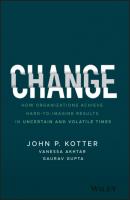Change. Gaurav Gupta
Чтение книги онлайн.

Читать онлайн книгу Change - Gaurav Gupta страница 12
Название: Change
Автор: Gaurav Gupta
Издательство: John Wiley & Sons Limited
Жанр: Управление, подбор персонала
isbn: 9781119815884
isbn:
It is now increasingly clear that these larger-than-life leaders avoided common pitfalls and mobilized action not just intermittently, not just once, but all the time, iteratively, often for years. Our most recent research is showing that's precisely what organizations need to do in a new era of speed, complexity, and uncertainty—similar actions taken not once a decade but continuously.
The net result of all this activity often astounds people. As a result, they may come to see these leaders as highly compelling, heroic, or charismatic. However, the causality often runs in a different direction. It is less that charisma mobilizes others to produce astounding results and more that Thrive-activating behavior (grounded in an understanding of human nature, modern organizations, and leading change) mobilizes people to produce outstanding results despite all the barriers. This accomplishment creates a perception that the “leader” is heroic and charismatic.
This last point is important because it helps explain why organizations without larger-than-life leaders—which is to say, almost all entities—can also produce astonishing results. They can use diverse teams that create a very similar process of mobilizing and leading others to achieve great change.
Research on leading change successfully today shows that teams drive broad-based action by behaving according to a set of guiding principles.
First, they hold themselves and others accountable to have-to tasks, but they also realize that a want-to, emotionally positive, almost volunteer attitude is essential in mobilizing people to go on a rapid-change journey. Second, they are rational and analytical, but they also win over hearts to get true buy-in, energized volunteerism, and that want-to positive attitude. Third, they are good at management and they develop and promote excellence in the planning, organizing, and controlling so central to modern organizations. But much more than is common today, they also encourage and support leadership from many people, not just from a few of their peers at the top of an organization. Fourth, they use small, highly select groups to attack certain change tasks. Yet they also heavily rely on the diverse many—a group big enough and with the breadth of information and contacts both to figure out what changes are needed and to execute them despite human nature and organizational barriers.
Together, these four points can be thought of as guiding principles associated with accelerating change in complex organizations. They help drive a momentum-building process of leadership that inspires buy-in and action, which creates more leadership, which overcomes more organizational and human barriers, which gets results, which creates more and more opportunity.
Because a management hierarchy can fight this process and is not designed to foster volunteerism, a want-to attitude, and leadership up and down the hierarchy, the most successful change teams now create a second system to facilitate the work, a system built not on formal hierarchy but on fluid networks.
That is, though modern enterprises are organized for good reasons by hierarchy, especially to create efficiency and reliability, change leadership teams also use fluid networks of people to tackle most of the big-change tasks. They create what we have called a “dual system.” Hierarchy and controls are central mechanisms to executing operating plans. Networks and leadership from the diverse many are at the core of driving strategic initiatives. This dual system is critical in reinforcing, sustaining, and embedding business outcomes and new ways of working associated with a successful change effort. We will have more to say about this later.
The Three Streams
Taken together, these three streams of research show us why we struggle with change, why the struggle will only grow unless we act now, and what highly effective action increasingly means.
Furthermore, these same principles and processes appear to apply to all complex change challenges and change methodologies, whether they are seen as and labeled as digital/IT, cultural, or even cost cutting (restructuring).
This insight is not widely recognized. Mergers and acquisitions, for example, are treated as a totally different set of tasks than digital transformation. Restructuring is treated as a whole different activity than employing Agile principles. Yet these, as well as some other arenas, all share a very basic reality. They are methods used to help organizations accelerate adaptation or transformation to try to take advantage of a more rapidly changing and volatile world.
More often than not, as you will see in the upcoming chapters, people succeed or struggle in all these areas for the very same reasons—reasons that are less related to digital technologies or M&A genius or Agile or restructuring, and more to do with change principles and processes, the nature of modern organizations, and human Survive and Thrive hardwiring.
A note to all readers: Part II of this book devotes a chapter to each of the methods shown above in the diagram. If you are deeply engaged in one of the methodologies shown in that exhibit and are pressed for time, we suggest you next read the chapter on that method and the last two chapters of the book. You can then decide when and how to engage with the rest of the material.
Конец ознакомительного фрагмента.
Текст предоставлен ООО «ЛитРес».
Прочитайте эту книгу целиком, купив полную легальную версию на ЛитРес.
Безопасно оплатить книгу можно банковской картой Visa, MasterCard, Maestro, со счета мобильного телефона, с платежного терминала, в салоне МТС или Связной, через PayPal, WebMoney, Яндекс.Деньги, QIWI Кошелек, бонусными картами или другим удобным Вам способом.